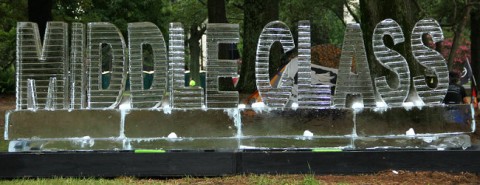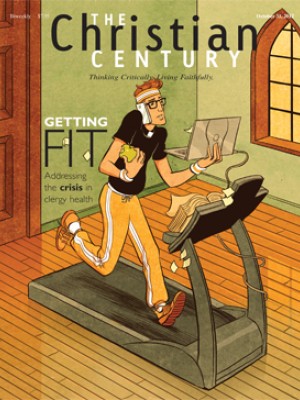Defining the middle: The rhetoric and reality of class
An Episcopal priest who, with her husband, brings in about $65,000 a year tells Marketplace that they are lower middle class. A woman posting at dcurbanmom.com identifies her family as middle class, and their income is $100,000 a year. CNN talks to a man struggling to save for his son’s education who defines “middle class” as families with too much to qualify for federal Pell Grants—which is at most about $48,000 for a family of three. I was eligible for Pell Grants, and before that for subsidized school lunches, but I’ve always understood my family of origin to be middle class.
A majority of Americans consider themselves middle class, a recent Pew survey found, despite a wide variance in their earnings. So what does “middle class” mean if it applies to most of the country? And if we are all middle class now, what are the political and cultural implications?
Read our latest issue or browse back issues.
Unlike middle class, the word poor has an official meaning. The U.S. Department of Health and Human Services’ poverty formula is notoriously crude and inadequate, but at least it spits out a number: currently, an individual with annual earnings of less than $11,170 is considered poor ($23,050 for a family of four) and thus is eligible for various safety-net programs. (The Census Bureau uses a slightly different measure for statistical purposes.) Some services are available as well to those earning up to a given multiple of the poverty line—especially the 200 percent mark, under which a family is generally considered “low income.”
No such official definition of middle class exists. But it’s easy enough to identify some reasonable approaches and crunch the numbers accordingly. According to the Census, the median U.S. household income is $50,054. The Census doesn’t split households into three groups of equal size, but on the basis of the data it does provide we can estimate that doing so would produce a middle group earning roughly $32,000 to $76,000. Or use the Census’s preferred breakdown—by quintile—and call groups two through four “lower middle” ($20,263–38,520), “middle” ($38,521–62,434) and “upper middle” ($62,435–101,582). Sociologists have also proposed more complex definitions that factor in variables such as location, education level, occupation type and cultural identification.
HHS endorses none of these approaches. It has no reason to. Unlike being poor or low-income, being middle class doesn’t afford you access to a discrete set of government services. It does, however, give you the pleasure of hearing politicians talk a lot about how great you are—and about all the different ways they plan to make your life better.
Governor Romney states regularly that his antitax agenda would benefit the middle class, a claim he supports mostly with vague rhetoric about small businesses and “job creators.” Asked what counts as middle class, he responded “$200,000 to $250,000 and less”—more than 95 percent of the country.
But it’s the Democrats who have long since worn out the keys in middle class on their laptops, and they usually define the term much as Romney does. President Obama waves the pro-middle-class flag often; he draws the upper line at $250,000. Sometimes the president simply implies that the whole massive group under this line constitutes the middle class. Other times he speaks also of those struggling to get into the middle class in the first place, which is about as close as most politicians get to saying the word poor anymore.
Fifteen percent of American households are officially poor, and 2 percent earn more than $250,000. If the middle class’s ceiling is $250,000 and its floor is the poverty line, then 83 percent of Americans are middle class. That number defies common sense. So does the suggestion that a family earning a quarter million dollars is of the same economic class as one making less than a tenth of that. The two live in fundamentally different economic worlds.
But is this all just semantics? It may be odd to use the term middle class to refer to the vast majority of people—the well-off and the struggling alike—but what’s the harm?
Democratic strategists may not see much of a downside. The reason the party doesn’t talk about poverty much is that poor people don’t vote much. So when discussing antipoverty programs—something Democrats still find it in themselves to do from time to time—party leaders tend to substitute the term middle class. Why not spin services for the poor as services for the group where most of the votes are?
The Democrats also have much to gain from a stronger sense of solidarity between the bottom and the middle—as well as between both groups and those who are well-off but not extremely so. Expansive references to the middle class can be an effective tool in this effort. As community organizers understand well, most poor people don’t want to join a poor people’s movement. What they want is not to be poor anymore—to be part of something larger, more promising and more dignified than a label that often reeks of crushing hopelessness. As for the fairly well-off, many self-identity as middle or upper-middle class rather than rich. In a culture that worships wealth but has deep ambivalence about the wealthy, having the first without being the second is the best of both worlds.
The Occupy movement captured this sense of broad solidarity with its slogan “We are the 99 percent.” Occupy fiercely resisted being co-opted by the establishment left, much less by the Democratic Party. But the Democrats would have liked nothing more than to be able to turn this broad sense of frustration with the superrich into organizing around the notion of a middle-class vote.
Of course, they would have to tweak the slogan’s number—but only by a point. When Obama brings up the $250,000 income threshold, it’s generally in reference to his plan to keep the Bush tax cuts in place for those earning less than this—the bottom 98 percent. This is the most obvious example of a Democratic play for broadly populist solidarity.
To be clear, it’s also good economic policy—for now. With the economy recovering at a sluggish pace, it would be counterproductive to increase taxes from their current rates for any but the wealthiest Americans. That’s because most everyone else spends more money when their taxes are lower, which in turn stimulates the economy. The deficit can wait.
But it can’t wait forever. Once the economy is back on its feet, it will be time to move toward running surplus budgets again, to chisel away at the national debt. This may well require massive, socially crippling spending cuts—unless cuts can be tempered with significant revenue increases. And these revenues can’t come from just the top 2 percent of households. Assuming we’re talking about modest, politically plausible increases—not a return to the old days of making the wealthy pay a majority of their income in taxes—there just aren’t enough of them to make a big enough difference.
Restoring the Clinton-era tax rates on incomes above $186,000, however, would raise new revenue from 5 percent of Americans—more than twice those affected by the policy Obama currently favors. Move the cutoff down to $101,582 and you have 20 percent, a sizable group of Americans who can afford to pay more taxes and who, by doing so, could do a great deal to restore the federal government to fiscal health.
Raising taxes on these households, however, is an extraordinarily difficult political task. And it gets harder each time Obama, Romney or anyone else reinforces the idea that $249,999 is a middle-class income. One thing voters tend to agree about is that the middle class—whoever they are—should not see tax increases. The Democrats’ tax policy is the right one for now, but their constant invocation of the middle class in promoting it is troubling in light of longer-term budget woes—and the common good.
The middle class as a concept is close to the heart of the American socioeconomic imagination. Our social compact has long maintained that society has an interest in all its members having a basic standard of living. Yet whatever the rhetoric of red scares old and new, the U.S. has never tread very close to the welfare-state model of many other developed nations. For better or for worse, social welfare is not at the core of the American dream. Social mobility is: Americans have long seen class as a fluid, flexible thing. As a practical reality, mobility looks pretty shaky these days. But as a concept it continues to animate our thinking. It’s a politics of aspiration: we aspire to move up in the world. And this has everything to do with our definition of the middle class.
The poor aspire to be middle class, and indeed it is a moral imperative for society to make this possible. The federal safety net includes some straightforward income supports, such as food stamps: people need to eat, so we have this program that helps them buy food. But much social spending—welfare-to-work, the earned income tax credit, subsidies for higher education—is aimed specifically at building paths out of poverty and is evaluated accordingly.
More troubling is the fact that so many ostensibly middle-class Americans aspire to be rich. The middle class is thus seen as an intermediate stop, not a destination. The story is rags to riches; stability, everyday comforts and modest vacations are merely landmarks along the way. If we accept $250,000 as the upper end of middle class, then we make it easy for people with six-figure incomes to believe they haven’t arrived yet.
In the July issue of GQ, Jon Ronson profiles six individuals and households that represent different spots on the U.S. income scale. Like the Census, Ronson defines these income cohorts using simple math. But he doesn’t split the populace into six groups of equal size. Instead, each person he profiles makes five times more than the one before. Ronson jumps from an impoverished dishwasher to a two-income family of four making a little more than $45,000—“low-income” in policy parlance, but not by much. Then he considers his own place in the pecking order of magnitude, with his earnings of “about $250,000, double that in a good year.” From there it’s three levels of stratosphere, each person more fabulously wealthy than the one before.
On the road between the $45,000 family and a woman making from $1.25 million to $3 million, Ronson offers this by way of transition: “I have never felt so rich and so fortunate as I do when I drive away from Urbandale that morning. But the feeling doesn’t last.” Soon he’s envying the millionaire woman. (Even she declines to self-apply the label “rich.”) And why not envy her? Though Ronson’s a member of the top 2 percent, he’s framed his story to place himself at the lower end of middle. And as long as you’re in the middle, there is more to aspire to.
Meanwhile, the growth of income inequality continues unabated. (To be fair to Ronson, his approach to writing about class emphasizes this fact as well.) The latest Census data find a greater concentration of income among the top 5 percent of earners, along with a growing number of people who can’t break the low-income threshold. The more we cut the safety net—a trend that will be hard to reverse without raising taxes on more than 2 percent of Americans—the worse these inequality numbers will be.
It’s a great irony: the mathematical middle class shrivels while the rhetorical middle class swells and thrives. Our expansive use of the term middle class gives 98 percent of the people permission to feel that they’re missing out on the good life, that they should keep grasping for more. But the aspirations of the relatively well-off should not stand in the way of the basic needs of those the economy is leaving behind.
The solution to all this isn’t simple, but it includes a simple rhetorical shift: daring to call those with six-figure salaries what, by any reasonable statistical measure, they are—rich.
Jeremiah Wright, Obama’s former pastor, is a gifted preacher and a perceptive critic of American economic culture. Before he was nationally infamous for opinionated preaching while black, Wright was known for warning his parishioners against what he called “middle-classness.” He wasn’t calling for voluntary poverty. That would be a strange message in his black urban context, in which poverty of the involuntary variety is commonplace. Wright was referring instead to an attitude, a view of one’s position and ethical duty in the world. Do not be consumed by the politics of aspiration, he was saying. Don’t let concern for your own comfort and stability eclipse your vision of the common good. Avoid middle-classness.
That’s a message we need to hear. The American dream mythology remains robust, our collective vision of the common good seems faint, and our politics seem ever more dysfunctional. It’s no easy thing to avoid middle-classness. One good step, however, is to stop throwing the term middle class around so loosely.








